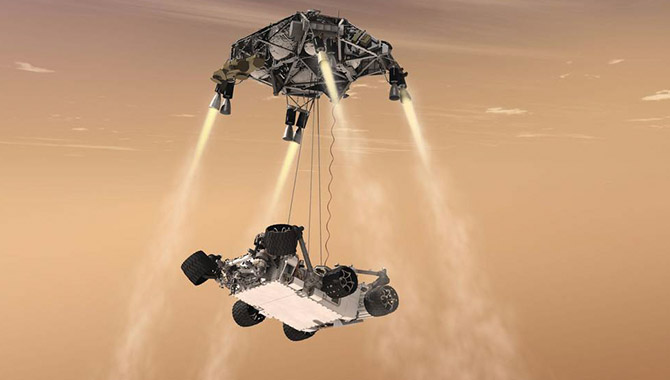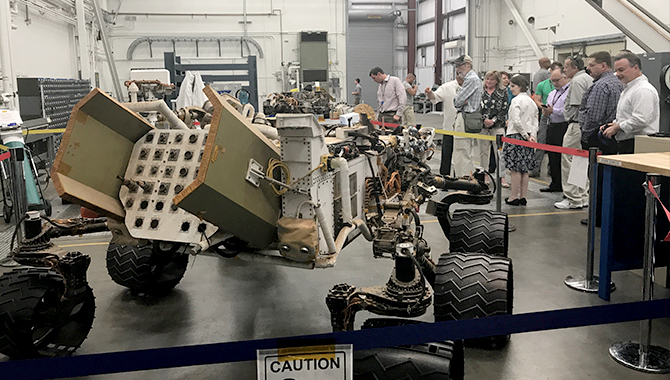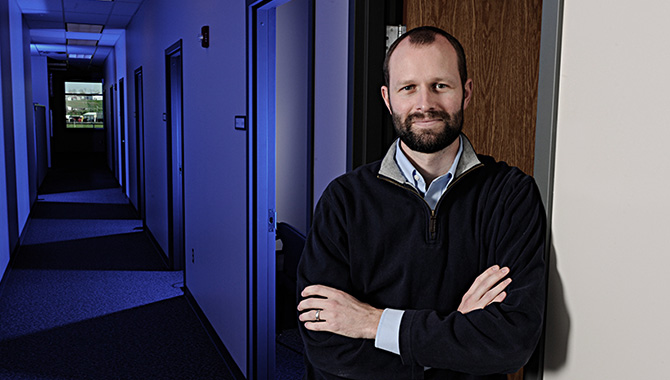
This artist's concept shows the sky crane maneuver during the descent of NASA's Curiosity rover to the Martian surface.
NASA HQ was the host site for the 25th Quarterly Federal Knowledge Management Community (FKMC) meeting March 10, 2017.
Founded in 2010, the FKMC is a vibrant volunteer organization of over 240 practitioners. It is a collaboration of federal employees from many federal departments and agencies, along with contractors who work in direct support of members and employees of selected nonprofit and non-governmental organization (NGO) groups. The community meets face-to-face quarterly to leverage leading practices, share challenges and get help, and learn at a host federal agency. Members also have the option to participate remotely in the daylong meeting.
The meeting participants were treated to presentations by two excellent speakers who shared best practices in knowledge management (KM) in their organizations. David Oberhettinger, Jet Propulsion Laboratory (JPL) Chief Knowledge Officer (CKO), spoke to the community about “Knowledge Management in a High Risk Environment”, and Alex Linthicum, Knowledge Management Officer at the Volpe National Transportation Systems Center, spoke on “Like Peanut Butter and Jelly: 5 Tips for Making KM a Natural Fit for your Organization.”
As the lead NASA center for robotic exploration of the solar system, JPL has four rovers on Mars. Because each rover has been a uniquely designed vehicle, each mission to Mars has been a high risk exploration mission, one that has never before been attempted. Oberhettinger said JPL invents products where they may make only a single unit – which may cost a billion dollars – and the unit is designed to go somewhere previously unreachable. The high value units must operate with precision in extremely hostile environments.
Oberhettinger shared that extreme risk requires extreme engineering, and the engineering expertise resident at JPL is extreme in its uniqueness since no one else has the experience working on the Mars rover missions.
So, why is knowledge husbandry critical to continued success at JPL? Often, corporate knowledge is treated as if it has little value, and it may be lost unless leadership supports active measures to capture it, according to Oberhettinger. Loss of knowledge happens when practitioners retire or leave their jobs. When this happens their organizational knowledge, unless captured, can never be recovered. Knowledge simply walks out the door.
On July 20, 1976, at 8:12 a.m. EDT, NASA received the signal that the Viking Lander 1 successfully reached the Martian surface.Photo Credit: NASA
A good example Oberhettinger shared is that when the Mars Curiosity was built, it was much larger and heavier than its predecessors, so the landing method needed a redesign. It was decided to build a Sky Crane that would hover over Mars as it gently dropped the rover to the ground on descent. The technology required throttleable thrusters where the output could be adjusted like an accelerator pedal that varies car engine output.
“Well, NASA hadn’t designed these thrusters since the Mars Viking Lander in the 1970s, and failed as an institution to retain that knowledge. In the ensuing 40-plus years, the Viking Lander engineers had all retired, and the knowledge was lost,” said Oberhettinger. “Fortunately, JPL was able to track down a few of the retirees that were still alive, and we were able to help the rover engineers design the current thruster systems.”
As JPL’s CKO, Oberhettinger shared the knowledge management practices that have made JPL an organization that values knowledge capture and sharing:
- Obtaining leadership commitment
- Establishing a KM strategic plan that articulates what knowledge is critical, where the gaps are in capturing, retaining and sharing knowledge, and what activities should be taken to address the gaps
- Adopting industry-wide best practices, such as formalizing lessons learned processes and mentoring junior staff
- Serving as a knowledge champion in the organization
- Making good use of what the organization knows
Image Credit: Volpe
Alex Linthicum grabbed everyone’s attention by explaining that at Volpe, knowledge management is defined as “helping people find who or what they are looking for.” He also said that the words “knowledge management” aren’t really used that often in his organization because to some, those words are ambiguous. Instead, Volpe uses words describing how and where knowledge is captured, stored and shared, such as formal mentoring, communities of practice, the intranet, the organizational taxonomy, Volpe’s guiding principles, their Innovation Challenge, the Volpe Library and dashboards that give people concrete places or groups where they can find who or what they are looking for.
Linthicum shared his wisdom for making KM a good fit in any organization. He encouraged practitioners to:
- Understand their organization — not just the org chart version, but also the mission, culture, roles, the knowledge that people need to do their jobs, and what KM activities and programs already exist in the organization that go by a different name (like mentoring).
- Get to know the “knowledge” that needs to be “managed,” e.g., staff skills and experiences; critical knowledge needed to perform jobs; sponsor organizations and contacts; projects; internal processes and resources; and industry trends. Like Oberhettinger, he suggested a gap analysis for the current and future state of knowledge, and activities to undertake to get to the desired state.
- Develop guiding principles. For instance, use internal articles to curate, preserve and find institutional memory, and tie existing data and information to an organizational taxonomy so it is easier to find.
- Achieve quick wins. Focus on allies, track progress and communicate wins.
- Communicate often. Devise simple messages to explain KM like “connect people with people” or “empower staff to find what they need.” Tell people what you are doing, and how it is helping them.
Both Oberhettinger and Linthicum shared powerful messages, elegant in their simplicity. Their presentations are available to Federal KM Community Members (only) at APAN.org. For more on Mapping Your Knowledge Assets, go to HBR.org.
The FKMC wrapped up its quarterly meeting with round-robin style member updates on current initiatives and challenges. The community’s next meeting will be held in June at Defense Media Activity (DMA) and Defense Information Systems Agency (DISA) in Fort Meade, Maryland.









